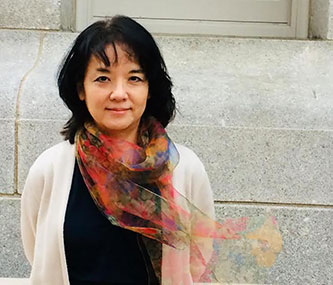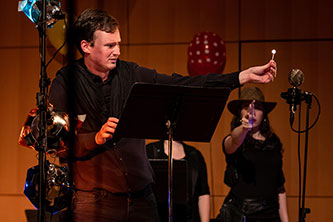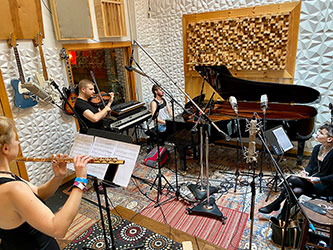American Music Review
Vol. L, Issue 2, Spring 2021
From coup d’état in January to COVID openings in June, the Spring 2021 academic semester challenged each one of us in new and hitherto unexpected ways. At Brooklyn College, the activities of the Hitchcock Institute continued remotely for the third semester since the start of the pandemic in Spring 2020, as did nearly all academic courses and musical performances. In spite of the ongoing complexities of the digital climate, the HISAM team assembled a memorable four-event, online Music in Polycultural America speaker series that not only brought out some of the most current research in the field of American music studies, but also highlighted the interdisciplinarity of our field. With that in mind, I am thrilled to announce that the Hitchcock Institute is now an affiliate of The Barry S. Brook Center for Music Research and Documentation (at the CUNY Graduate Center), host to a panoply of scholarly projects across disciplines. What’s more, in the spirit of dismantling the notion that single authors/presenters create the best work, you might notice that the speaker series has become increasingly collaborative.
Music in Polycultural America Speaker Series
Our first speaker of the semester, Stefan Sunandan Honisch, joined us from his position as a Banting Postdoctoral Fellow at the University of British Columbia to share his research on musical settings of Helen Keller’s poetry. Specifically, Honisch introduced us to Keller’s poem “A Chant of Darkness,” set by Italian composer Cesare Sodero as “Canto dall’Oscurità” for a premiere at the Brooklyn Academy of Music in 1919. Honisch contrasted this setting with one by Philip Greeley from 1939, performing close readings of both scores, while delicately disrupting pervasive narratives about Keller’s multiple disabilities as vehicles for overcoming and inspiration.
With a meticulously coordinated ten-minute DJ set, Will Fulton (BC/GC Musicology Alumni) opened Donna Lee Granville’s talk, “A Great White Hope? Interrogating the Place of White Rappers in the Hip Hop Hierarchy.” Drawing on her expertise as a sociologist who studies race, immigration, and culture, Granville utilized organizational theory to regard “rapper” and “DJ” as professions with specific qualifications, complicating this analysis with an understanding of whiteness as a hegemonic power.
Continuing the spirit of collaboration set forth by Granville and Fulton, Yoko Suzuki’s scholarship on midcentury virtuosa vibraphone player Terry Pollard inspired a rollicking Zoom performance, connecting Suzuki with MM Global Jazz candidate Victor Solano and his ensemble. Suzuki brought out details of Pollard’s career as both a jazz pianist and vibraphonist of extraordinary skill and charisma who toured and performed with her white male duo partner, Terry Gibbs. The spectacle of a Black woman and a white man playing in such close proximity on TV, and with such obvious passion, angered southern audiences while upending 1950s dynamics gender and race.
“A Legacy of Feminist Musicology”
The final event in our speaker series celebrated the “Legacy of Feminist Musicology” at the Hitchcock Institute. The afternoon of talks centered on three converging anniversaries: the twentieth anniversary of former HISAM director Ellie Hisama’s groundbreaking monograph Gendering Musical Modernism: Music of Marion Bauer, Miriam Gideon, and Ruth Crawford (Cambridge, 2001); the twentieth anniversary of the Institute’s conference, “Ruth Crawford Seeger’s Worlds,” (Brooklyn College, 2001) which brought together into one space Crawford’s art music compositions and folk music transcriptions; and the fifteenth anniversary of the collection of essays inspired by the Crawford conference, Ruth Crawford Seeger’s Worlds: Innovation and Tradition in Twentieth-Century American Music edited by Ellie M. Hisama and Ray Allen (Rochester, 2007).
Hisama, the impetus behind these acts of scholarly production, also represents a link between the formational days of the Institute in the 1970s and 1980s, when H. Wiley Hitchcock was director and Judith Tick and Carol Oja—both Hitchcock mentees during their PhD work at the CUNY Graduate Center—were lecturing on American music at Brooklyn College. Hisama followed Oja as the third director of the Institute when she arrived at Brooklyn College in 1999, joining jazz historian Jeffrey Taylor and ethnomusicologist Ray Allen.
The “Legacy” event, originally designed as a Keynote address by Hisama on her work as a scholar, mentor, and feminist activist in her fields, quickly expanded into an afternoon of panel talks and a performance. As one attendee noted afterwards, it’s not unusual to find an academic event or conference where a seminal book or scholar receives accolades and an assessment of their impact on the field. What is unusual is to find an event where that scholar is a woman. In the first panel session, Hisama discussed the influence of Gendering Musical Modernism with two of her former PhD advisees: Mary Robb, who works in the creative industries, and yours truly, the author of this HISAM newsletter! Both of us had written dissertations on New York composer Miriam Gideon thanks to Hisama’s book, and we reflected on how her mentorship has impacted our respective lives and careers.
The second panel session connected Ray Allen and Hisama to discuss the Ruth Crawford Seeger (RCS) Conference and subsequent collection with chapter contributor Nancy Rao (Rutgers University). Rao’s piece in the collection won the prestigious Irving Lowen’s award at the Society for American Music in 2008. Ruth Crawford’s own legacy brings together American folklore, ultramodern composition, and midcentury music education practice. Indeed, Crawford wrote her praxis across the fields of American music as broadly and deeply as humanly possible during her brief life. I had the pleasure of recording a brief statement from Judith Tick about the RCS conference, which we aired just before the session. But an even more spontaneous moment came in the form of a surprise appearance by Peggy Seeger. After Ray Allen recognized her attendance, she spoke about the moment of realization she felt when upon first hearing her mother’s compositions. She and her siblings had no idea that her mother was more than a teacher and folk song arranger, and Peggy related her anger at her father, Charles Seeger, for keeping that side of her mother from them. Nevertheless, she concluded with a twinkle in her eye (and here I paraphrase) that while men may compose phallic skyscrapers that explode out the top with one big bang, women tend to compose many, many less obvious yet equally climactic works throughout their lives. And we’re here to pay tribute to those many works.
Hisama’s keynote address, “A Life in American Music: Ruth Crawford, Julius Eastman, and Me,” found inspiration in Susan McClary’s article “Stradella and Me” from the Lives in Musicology series found in Acta Musicologica. As McClary traced her extraordinary career path via her scholarship on Stradella, Hisama narrated her remarkable journey by recognizing Crawford and Eastman as the intellectual touchstones of her work. In her first moments as a music theory MM student working with Joseph Straus at Queens College, she encountered Crawford’s String Quartet 1931, a work that would haunt her until she had written about it in her dissertation, and finally, in Gendering Musical Modernism. Along that road, Hisama developed a fierce feminist pedagogy and approach to research, which allowed her to consider Julius Eastman not only as an undersung post-minimalist composer, but also as the “gay guerilla” who was made to feel deeply abject within his social context. Hisama wound all of these details into the interdisciplinary trajectory that has led her to this moment, when she will step into her position as Dean of the Faculty of the Arts at the University of Toronto in August 2021.
The afternoon ended with a screening of Miriam Gideon’s 1958 opera, Fortunato: An Opera in Three Scenes, fully orchestrated by composer/conductor Whitney George and semi-staged in 2019 by The Curiosity Cabinet. Gideon left only a piano-vocal score and one fully- orchestrated scene among her papers, and George discussed the project of orchestrating the two remaining scenes based on the style of the first. Listening to vocal music by Gideon ended the conference on a suitably high note.
In This Issue: Conversation and Collaboration
Recalling Unit Structures, the recent conference organized by Michelle Yom on Cecil Taylor, Jessie Cox offers a posthumanistic interpretation of Taylor’s musical “scores,” arguing that they are less scores than resonances of embodiment, or collaborative entities of improvisation. Alana Murphy contributes a fascinating interview with Jonathan Zalben, composer and music supervisor for the Winter 2020 Disney series On Pointe. The series takes us inside the world of the American Ballet Theater’s 2019–20 season, including their production of the Nutcracker. Murphy and Zalben’s conversation brings out the Americanness of Balanchine ballet, how to score the streets of New York City, and the politics of representation. And Ray Allen reviews Can’t be Faded: Twenty Years in the New Orleans Brass Band Game (Mississippi 2020), co-written by ethnomusicologist Kyle DeCoste and the Stooges Brass Band themselves. In addition to reading the text with an eye to the musical and cultural content, Allen unpacks the “conscious collaboration” between the Stooges and DeCoste.
Staff News
We’re pleased to introduce a new member of the Hitchcock Institute team this year: Michelle Yom, flutist and PhD candidate at the Graduate Center in Musicology, has joined us as a contributing editor. You may recognize her as the organizer of the conference on Cecil Taylor that took place in October 2019. Welcome, Michelle!
Managing Editor Lindsey Eckenroth successfully defended her dissertation, “Listen Like This: Audiovisual Argument in Rockumentary,” which was nominated for the Barry S. Brook Dissertation Award. She’s excited to begin her new research on Lydia Lunch, the voice, and trauma in documentary film. Additionally, her article “Cars and Guitars, or, Detroit and the MC5: On Representations of Music and Place in MC5: A True Testimonial” was published in the collection Mapping the Rockumentary: Images of Sound and Fury, edited by Gunnar Iversen and Scott MacKenzie (Edinburgh University Press, 2021), and she gave a talk on this same topic at the virtual IASPM-US conference in late May. In flute news, Lindsey performed at the second annual Ukranian Contemporary Music Festival in March, and she recorded two pieces from Whitney George’s Solitude & Secrecy set, to be released on Pinch Records. Congratulations, Lindsey!
Hitchcock Institute Assistant Whitney George successfully defended her dissertation “For the Love of Inner Voices: Miriam Gideon, Orchestration & Fortunato” in December 2020, and was selected as a Pinch Records artist with two recordings of chamber works (For You and Solitude & Secrecy) to be released in 2021. She had two original songs commissioned by Marty Jeiven commemorating the life of his daughter; these will be performed by Lucas Bouk later this year. George’s music and the moving image lecture series with ThinkOlio continues to receive excellent reviews. Congratulations, Whitney!
Jeff Taylor continues his work on Earl Hines and the Chicago pianists, even as current events and academic discussions serve to shape the monograph’s narrative structure and content. He looks forward to reviving a long-planned project on the history of jazz in Brooklyn.
I had an extraordinarily busy semester, giving six public talks and turning in final drafts of two book chapters. Two highlights: At the “Music, Sound, and Trauma” conference held in February, I presented work from my forthcoming edited collection, Better Be Good to Me: Narratives of Domestic Violence in American Popular Music, along with four chapter contributors; and I had a rare chance to speak with film composer Laura Karpman about my new curriculum based on her score for the series Lovecraft Country.
Ray Allen took Travia leave during the Spring 2021 semester to work on his new book project and try retirement out for size. On a personal note, Ray has never hesitated to put on his “mentoring hat” when I asked for advice; never quailed at a letter, article, or review request; and in general, has been a driving force in bringing local and global music into the Conservatory at Brooklyn College. He will be sorely missed, but I will hold him to his promise to be an “active member of the advisory board.” (And don’t worry, Ray. I’m only going to wait a semester or two before I call on you to guest edit!) Thank you for everything.
In solidarity,
Stephanie Jensen-Moulton
Become a sustaining donor today at hisam.org.









